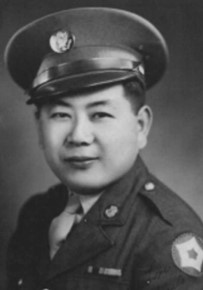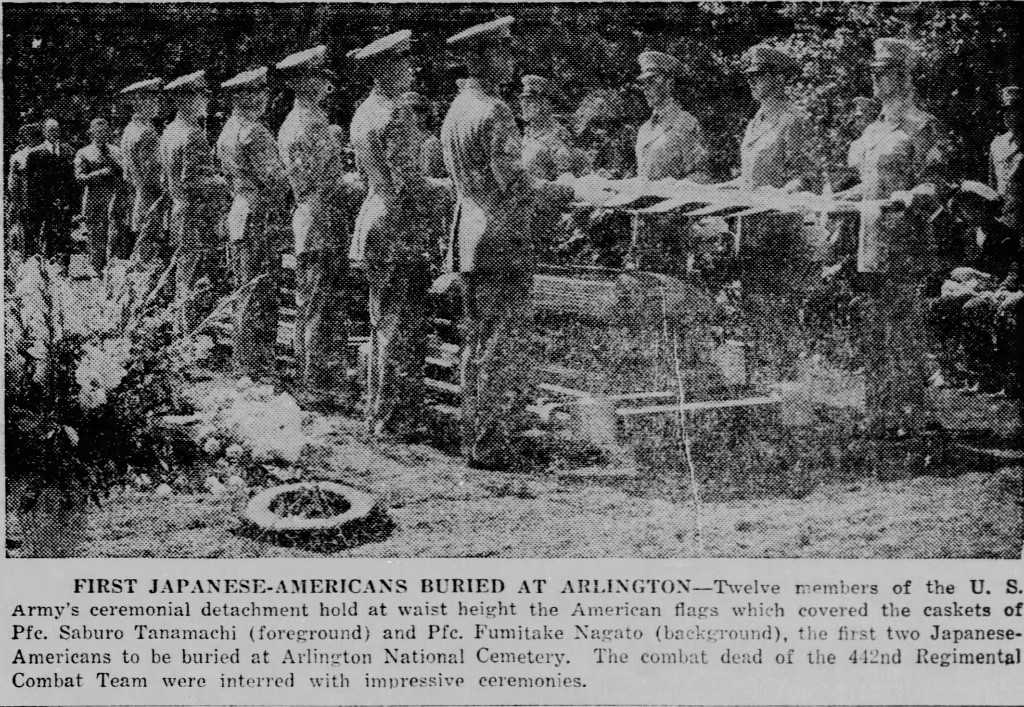
Fumitake Nagato
Private First Class
442nd Regimental Combat Team
2nd Battalion, G Company
Fumitake Nagato was born on August 2, 1918, in Los Angeles, California, to Bunzo and Take (Nagato) Nagato. His parents emigrated from the village of Uneme, Mie Prefecture, Japan. Bunzo arrived at Bellingham, Washington, on July 9, 1907. He returned to Japan and married Take there on July 1, 1911. Take arrived at San Francisco on September 8, 1917, on the Tenyo Maru. They raised a family of six children: sons Fumitake, Yoshiiwa, and Lincoln Masatoki; and daughters Yuriko, Mieko, and Iseko.
In 1920, Bunzo and Take lived as boarders with the Shiro Kobayashi family in Brawley Township, Westmorland District, Imperial Country, California, where he worked on the Kobayashi farm. In 1930, Bunzo and family lived in the same area and he was the manager on a vegetable ranch. Ten years later, they were in the same location and Bunzo was a farmer.
On October 10, 1940, Fumitake signed his draft registration card in Brawley, Local Board No. 158, Bank of America Building. At the time he was 5’3” tall and weighed 135 pounds. His father was listed as his point of contact, and they lived on Route 1, Brawley, where they were farmers.
Nagato enlisted in the U.S. Army on July 7, 1941. He was a truck farmer and had completed high school. Research has yet to reveal where he was sent for basic training or where he was stationed for the first 18 months of service. When the 442nd Regimental Combat Team was organized in February 1943, he was sent with other Japanese Americans in the U.S. Army to Camp Shelby, Mississippi, for training. He was assigned to 2nd Battalion, G Company.
Fumitake’s family were incarcerated on May 19, 1942, at Colorado River WRA Camp, also known as Poston, located near Parker, Arizona. They entered directly rather than through a WCCA Assembly Center.
After a year of basic and specialized training and military exercises, the 442nd left Camp Shelby by train for Camp Patrick Henry, Virginia, on April 22, 1944. On May 2, the 442nd left from nearby Hampton Roads in a convoy of over 100 ships, enroute to the Theater of War.
Once they arrived in the Mediterranean, the ship that carried most of the 2nd Battalion left the convoy and headed for port in Oran, Algeria. After offloading cargo, they rejoined the regiment at Naples, Italy, on June 17. The rest of the 442nd had arrived on May 28 and was by then in bivouac at nearby Bagnoli. Second Battalion followed the same route. They then went to a larger bivouac near Civitavecchia, about 50 miles north of Rome, where they went through additional training and final preparations for going to the front lines. The 442nd entered combat on June 26 near Suvereto in the Rome-Arno Campaign.
Nagato fought in all battles of the 442nd in the Rome-Arno Campaign. The Combat Team left for France on September 27. Once they arrived at Marseilles, they were in a bivouac area in nearby Septèmes until October 9, when they were transported north to fight in in the Rhineland-Vosges Campaign. They moved over 500 miles north to the Vosges Mountains by rail boxcar or truck convoy.
On October 14, 1944, the 442nd began moving into position in the late afternoon preparing the assault on Hills A, B, C, and D surrounding Bruyères, an important rail and road center. Each hill was heavily guarded, as each hill was key in order to take and secure the city. During the next three days the 442nd met heavy fighting and fierce resistance. On October 18, 2nd Battalion and 100th Battalion were set for a direct drive straight into the town. Their attack was preceded by a 30-minute artillery barrage on Hills A and B and the town itself. Two hours after the initial attack, G Company was still fighting in the open area between their line of departure and Hill B. After over six more hours of fighting, the Germans cracked and Bruyères was finally taken.
On October 19, 2nd and 3rd Battalions attacked Hill D, which fell within hours, although it was infiltrated by the Germans that night. The next day, October 20, saw very heavy fighting to secure Hills C and D and the road east of Bruyères.
Pfc. Fumitake Nagato was killed on October 20, 1944. The hospital admission card states he was hit in the thorax area and died in battle.
Private First Class Fumitake Nagato was buried in the nearby U.S. Military Cemetery at Epinal. He was survived by his parents and five siblings.
On December 3, 1944, a memorial service was held at the Colorado River Relocation Center for the thirteen sons of Poston internees who had been killed in the war at that point. Included was Pfc. Nagato, whose family was confined there. The service was arranged by the Poston Ex-Service Club, which included ten World War I Japanese veterans among the Poston internees.
For his military service, Pfc. Nagato was awarded the Bronze Star Medal, Purple Heart Medal, Distinguished Unit Badge, Good Conduct Medal, American Campaign Medal, European-African-Middle Eastern Campaign Medal with two bronze stars, World War II Victory Medal, and Combat Infantryman Badge. He was awarded the Congressional Gold Medal on October 5, 2010, along with the other veterans of the 100th/442nd Regimental Combat Team. This is the highest Congressional Civilian Medal.
After the war, most of the overseas military cemeteries were closed and families were given the choice of having their loved one reburied in one of the few remaining cemeteries or returned home. The Nagato family chose to have him brought home to where they were living in Arlington, Virginia.
On May 6, 1948, Pfc. Nagato’s remains arrived at New York on the USAT Lawrence Victory, along with those of 4,183 war dead aboard the ship, which sailed from Cherbourg, France, on April 27. The ship docked at Pier 3, Army Base Brooklyn, First Avenue and 59th Street, while flags throughout the city flew at half-staff. A memorial service at 11:00 a.m. was attended by about 800 family and friends. Eugene F. Bannigan, Brooklyn Assemblyman, delivered the chief address.
Fumitake Nagato was reinterred in Arlington National Cemetery on June 4, 1948, Section 12, Site 4607. One other Nisei soldier, Saburo Tanamachi, was buried at Arlington the same day and it was reported in the newspaper that these two soldiers were the first Japanese Americans buried on those hallowed grounds. The service was conducted by Major General Luther D. Miller, U.S. Army Chief of Chaplains. The Honorary Pallbearers included four members of Congress, four Major Generals, and General Jacob L. Devers, Chief of Army Field Forces, who commanded the Sixth Army Group under whom the 442nd fought in France.
Other pallbearers included Colonel Charles W. Pence, former commander of the 442nd until he was wounded in the Vosges battles; Colonel Virgil R. Miller, former commander of the 442nd RCT; Colonel Charles H. Owens, former commander of the 141st Infantry; and Lieutenant Colonel James M. Hanley, former Executive Officer of the 442nd.
below: Newspaper photo from Nagato’s burial at Arlington

In his eulogy at the burial, General Devers said:
There is one supreme, final test of loyalty to one’s native land – readiness and willingness, and if need be, to die for one’s country. These Americans, and their fellows, passed that test with colors flying. They proved their loyalty and devotion beyond all question. They volunteered for Army combat service, and they made a record second to none. In Europe, theirs was the combat team most feared by the enemy. In the Pacific, they placed themselves in double jeopardy, chancing the bullets of friends as well as foe. Everywhere, they were the soldiers most decorated for valor, most devoted to duty. Their only absences without leave were from hospitals which they quit before they recovered from their wounds, in order to get back into the fight for what they knew was right. These men, to two of whom we pay our heartfelt respects today, more than earned the right to be called just Americans, not Japanese Americans. Their Americanism may be described only by degree, and that the highest.
On September 19, 1955, Fumitake’s parents became naturalized US citizens at the U.S. District Court in Los Angeles.
His brother, Sgt. Yoshiiwa Nagato, 25th Infantry Division, U.S. Army, was killed in Vietnam on July 19, 1966. He was buried in the National Memorial Cemetery of the Pacific (Punchbowl) in Honolulu.
Researched and written by the Sons & Daughters of the Regimental Combat Team in 2023.
